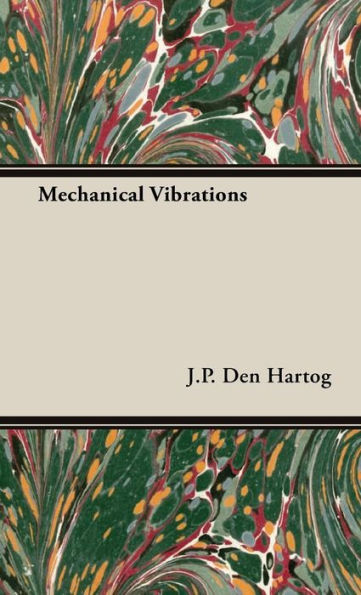

Hardcover(New Edition)
-
PICK UP IN STORECheck Availability at Nearby Stores
Available within 2 business hours
Related collections and offers
Overview

Product Details
| ISBN-13: | 9781443725361 |
|---|---|
| Publisher: | Crastre Press |
| Publication date: | 11/04/2008 |
| Edition description: | New Edition |
| Pages: | 496 |
| Product dimensions: | 5.50(w) x 8.50(h) x 1.25(d) |
About the Author
J. P. Den Hartog: The Reprint Engineer
J. P. Den Hartog (1901–1989), who taught for most of his career at MIT, was one of the founders of the Dover reprint program in engineering. As the author of several books that Dover reprinted and still has in print, and as an advisor from the 1950s until just a few years before his death in 1989, Professor Den Hartog gave invaluable advice concerning books of lasting interest and importance in his field.
Not many books in engineering have a productive shelf life spanning several decades. Among the exceptions are these four books of Professor Den Hartog, which Dover reprinted and occasionally revised in later printings from 1961 through 1987: Mechanics, 1961, Strength of Materials, 1961, Mechanical Vibrations, 1985, and Advanced Strength of Materials, 1987. Still widely read and cited by authors in these areas, Den Hartog's books are a tribute to his gift for exposition and clarity.
The J. P. Den Hartog Award, established in 1987, is presented in recognition of lifetime contributions to the teaching and practice of vibration engineering.
Table of Contents
PREFACE
LIST OF SYMBOLS
CHAPTER 1. KINEMATICS OF VIBRATION
1.1. Definitions
1.2. The Vector Method of Representing Vibrations
1.3. Beats
1.4. A Case of Hydraulic-turbine Penstock Vibration
1.5. Representation by Complex Numbers
1.6. Work Done on Harmonic Motions
1.7. Non-harmonic Periodic Motions
CHAPTER 2. THE SINGLE-DEGREE-OF-FREEDOM SYSTEM
2.1. Degrees of Freedom
2.2. Derivation of the Differential Equation
2.3. Other Cases
2.4. Free Vibrations without Damping
2.5. Examples
2.6. Free Vibrations with Viscous Damping
2.7. Forced Vibrations without Damping
2.8. Forced Vibrations with Viscous Damping
2.9. Frequency-measuring Instruments
2.10. Seismic Instruments
2.11. Electrical Measuring Instruments
2.12. Theory of Vibration Isolation
2.13. Application to Single-phase Electrical Machinery
2.14. Application to Automobiles; Floating Power
CHAPTER 3. TWO DEGREES OF FREEDOM
3.1. Free Vibrations; Natural Modes
3.2. The Undamped Dynamic Vibration Absorber
3.3. The Damped Vibration Absorber
3.4. Ship Stabilization
3.5. Automobile Shock Absorbers
3.6. Isolation of Non-rigid Foundations
CHAPTER 4. MANY DEGREES OF FREEDOM
4.1. Free Vibrations without Damping
4.2. Forced Vibrations without Damping
4.3. Free and Forced Vibrations with Damping
4.4. Strings and Organ Pipes; Longitudinal and Torsional Vibrations of Uniform Bars
4.5. Rayleigh's Method
4.6. Bending Vibrations of Uniform Beams
4.7. Beams of Variable Cross Section
4.8. Normal Functions and Their Applications
4.9. Stodola's Method for Higher Modes
4.10. "Rings, Membrances, and Plates"
CHAPTER 5. MULTICYLINDER ENGINES
5.1. Troubles Peculiar to Reciprocating Engines
5.2. Dynamics of the Crank Mechanism
5.3. Inertia Balance of Multicylinder Engines
5.4. Natural Frequencies of Torsional Vibration
5.5. Numerical Example
5.6. Torque Analysis
5.7. Work Done by Torque on Crank-shaft Oscillation
5.8. Damping of Torsional Vibration; Propeller Damping
5.9. Dampers and Other Means of Mitigating Torsional Vibration
CHAPTER 6. ROTATING MACHINERY
6.1. Critical Speeds
6.2. Holzer's Method for Flexural Critical Speeds
6.3. Balancing of Solid Rotors
6.4. Simultaneous Balancing in Two Planes
6.5. Balancing of Flexible Rotors; Field Balancing
6.6. Secondary Critical Speeds
6.7. Critical Speeds of Helicopter Rotors
6.8. Gyroscopic Effects
6.9. Frame Vibration in Electrical Machines
6.10. Vibration of Propellers
6.11. Vibration of Steam-turbine Wheels and Blades
CHAPTER 7. SELF-EXCITED VIBRATIONS
7.1. General
7.2. Mathematical Criterion of Stability
7.3. Instability Caused by Friction
7.4. Internal Hysteresis of Shafts and Oil-film Lubrication in Bearings as Causes of Instability
7.5. Galloping of Electric Transmission Lines
7.6. Kármán Vortices
7.7. Hunting of Steam-engine Governors
7.8. Diesel-engine Fuel-injection Valves
7.9. Vibrations of Turbines Caused by Leakage of Steam or Water
7.10. Airplane-wing Flutter
7.11. Wheel Shimmy
CHAPTER 8. SYSTEMS WITH VARIABLE OR NON-LINEAR CHARACTERISTICS
8.1. The Principle of Superposition
8.2. Examples of Systems with Variable Elasticity
8.3. Solution of the Equation
8.4. Interpretation of the Result
8.5. Examples of Non-linear Systems
8.6. Free Vibrations with Non-linear Characteristics
8.7. Relaxation Oscillations
8.8. Forced Vibrations with Non-linear Springs
8.9. Forced Vibrations with Non-linear Damping
8.10. Subharmonic Resonance
PROBLEMS
ANSWERS TO PROBLEMS
APPENDIX: A COLLECTION OF FORMULAS
INDEX
